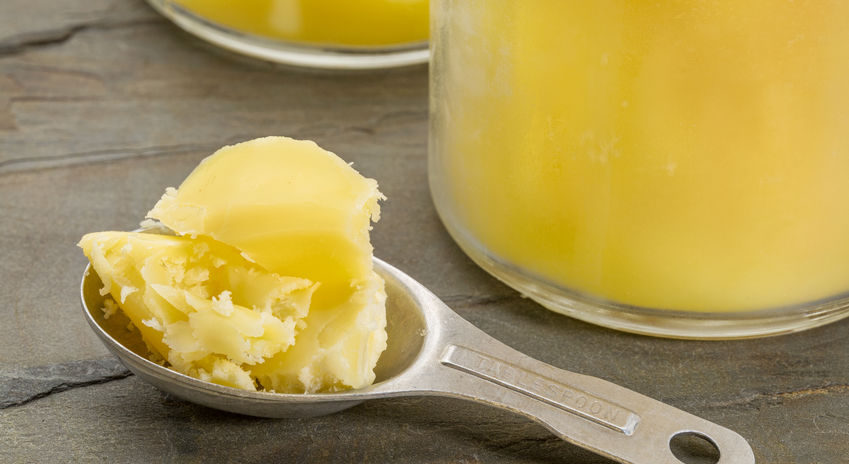Internal and external uses of ghee
Ghee as an elixir of life
Ghee is an unrecognised "superfood" and provides the body with important vital substances: high-quality fats and fat-soluble vitamins. Because of its similarity to the body's own fats that keep our tissues and skin supple, ghee is also excellent for external applications.
Ghee is indispensable in Ayurvedic cooking. Its high flash point makes it ideal for sautéing spices and vegetables without creating harmful free radicals. Added to the finished food, ghee is nourishing for the whole body and has an anti-inflammatory effect on the mucous membranes of the gastrointestinal tract.
Ghee and the digestive system
Due to the stress of modern life and the use of convenience foods, a large number of people today suffer from inflammation of the gastrointestinal tract. These are often diagnosed as food intolerances, lactose and fructose intolerance, histamine intolerance or leaky gut. Ghee contains the fatty acids that a healthy intestinal wall needs for the formation of dense mucous membranes. A healthy intestine is a guarantee for health in the rest of the body. Only when the intestine is intact can the body fully absorb the vital substances from food and completely eliminate the waste products of the metabolism.
Ghee and the nervous system
Our brain and nerves are basically just "highly specialised fatty tissue". A diet of low quality fats, poor in the fat-soluble vitamins A, D and E, prevents the nervous system from getting the nutrients it needs for constant regeneration. Loss of resilience, performance, memory and emotional stability are the consequences. Ghee is used in Ayurveda both as a pure substance and in combination with medicinal herbs as an important "brain fertiliser". 
External use
Not only the mucous membranes, nerve cells and connective tissue inside the body need high-quality fatty acids as building blocks. The skin and all body orifices also owe their elasticity and their firmness for the protective effect of the body to the various fatty acids. These are present in ghee in an optimal composition.
Applications for wounds and stubborn calluses
Ghee promotes wound healing and supports scar formation. Old painful scars, which can also act as an energetic interference field in the body, should also be treated with ghee rubs. Ghee, optionally mixed with turmeric powder, can be applied to both fresh and poorly healing wounds to accelerate the healing process. A lifelong problem is often caused by stubborn corneas with gaps on the soles of the feet and dry eczema on the palms of the hands. Ghee is also excellent as a "healing ointment" for these types of complaints. A simple recommendation is to apply plenty of ghee to calluses and chapped skin before sleeping and to put the feet or hands in plastic bags overnight to protect the bed.
Ghee and eyes
Many people suffer from the problem of "dry eyes". The natural moisturising of the eyes consists of a watery component and a film of fatty substances. Environmental stress, dry indoor air, computer work and also age-related hormonal changes lead to the fact that the fatty film in the eye is no longer sufficiently formed. The result is reddened and constantly watery eyes, a feeling of scratching and rubbing every time the eyes blink. The simplest ghee application for this is to rub ghee on the eyelids before sleeping. This should be done daily for a few weeks, then the body can form the necessary greasy film again. If this is not enough, Ayurveda recommends ghee eye baths (Netra Tarpana). These eye baths can be used in an Ayurvedic health centre as well as in a simplified form at home.
Ghee for the nose
Dry indoor air, dust and fine dust pollution and again hormonal changes can dry out the mucous membranes of the nose and sinuses. If dryness of the mucous membranes is a problem, putting small amounts of ghee into the nostrils is an excellent way to protect against dehydration. Ghee can thus also be used to prevent frequent nosebleeds and colds caused by dry heating air in winter.
Vaginal dryness
Many women in the menopause suffer severely from vaginal dryness. Apart from burning sensations in everyday life, this condition can lead to serious problems in the partnership because the dryness makes normal married life and sexual sensation impossible. Ghee for vaginal application is perceived by many women as a "miracle cure". The vaginal application of ghee leads to immediate well-being both when used regularly for maintenance and when needed to facilitate union.
Ghee and sleep
For people with heat-related sleep disorders, ghee should be used not only internally for nourishment and as a carrier substance for herbal remedies, but also externally. Through its cooling effect, it helps to relieve night sweats, violent dreams and sleep interruptions. To achieve this, small amounts of ghee are applied to the forehead and navel before sleeping. The ghee is simply massaged in with the three middle fingers of the right hand in a gentle clockwise circular motion over the root of the nose. Also massage around the navel for 1-2 minutes with gentle clockwise circular movements of the flat hand.
Triphala Ghee
An increase in the effect of ghee when used for sleep disorders can be achieved with Triphala Ghee. Triphala Ghee is not only used on the forehead and navel for these complaints as described above, but also for a gentle foot massage before going to bed.


We look forward to your feedback!